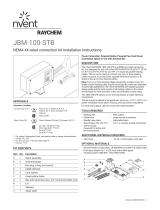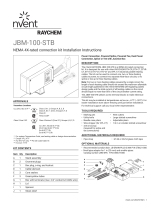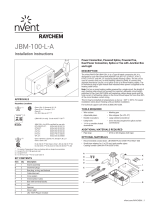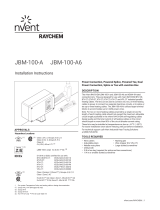Page is loading ...

nVent.com/RAYCHEM
|
1
JBS-100-STB
Single Entry Power Connection With Junction Box
Installation Instructions
nVent.com
DESCRIPTION
The nVent RAYCHEM JBS-100-STB is a NEMA 4X rated power
connection kit. It is designed for use with BTV-CR, BTV-CT, QTVR-CT,
XTV-CT, KTV-CT, HTV-CT and VPL-CT industrial parallel heating cables.
The JBS-100-STB utilizes screw terminal blocks to connect the
heating cable to power.
This kit may be installed at temperatures as low as −67°F (−55°C).
For easier installation store above freezing until just before
installation.
For technical support call your local nVent representative.
TOOLS REQUIRED
• Wire cutters • Pliers or adjustable wrench
• Utility knife • Needle nose pliers
• Large slotted screwdriver • Marker
• 1/4 in or smaller flat-blade screwdriver
• Wire stripper (for VPL-CT)
ADDITIONAL MATERIALS REQUIRED
• Pipe strap • GT-66 or GS-54 glass cloth tape
OPTIONAL MATERIALS
• Recommended conduit drain:
JB-DRAIN-PLUG-3/4INP/N 278621-000
• Small pipe adapter for 1 in (25 mm) and smaller pipes:
Catalog number JBS-SPAP/N E90515-000
APPROVALS
Class I, Div. 2, Groups A, B, C, D
Class II, Div. 1 and 2, Groups E, F, G
Class III
(3) Temp Code*
(2) Class I Division 2 (Zone 2**), Groups A, B, C, D
Class I Zone 2 IIC
CL I ZN 1 AEx eb IIC T* Gb
ZN 21 AEx tb IIIC T*°C Db
Ex eb IIC T* Gb
Ex tb IIIC T*°C Db
CLI, ZN1, AEx e II* (1)
Hazardous Locations
* For system Temperature Code, see heating cable or design documentation.
(1) Except VPL, HTV
(2) For HTV-CT only ** Per CE Code Table 18
(3) Except HTV
A
D
G
F
E
B
C
KIT CONTENTS
Item Qty Description
A 1 Stand
B 1 Core sealer
C 1 Green/yellow tube
D 1 Cable lubricant
E 1 Cable tie
F 1 Lid
G 1 Box with terminal block
Hazardous Locations

2 | nVent.com/RAYCHEM
BTV-CR, BTV-CT, QTVR-CT XTV-CT, KTV-CT
VPL-CT HTV-CT
Outer Jacket
Braid
Conductive Core + Electrical Insulation
Bus Wire
BTV-CR, BTV-CT, QTVR-CT XTV-CT, KTV-CT
VPL-CT HTV-CT
Outer Jacket
Braid
Conductive Core + Electrical Insulation
Bus Wire
Heating cable types
This component is an electrical device that must be installed
correctly to ensure proper operation and to prevent shock or
fire. Read these important warnings and carefully follow all of
the installation instructions.
• To minimize the danger of fire from sustained electrical
arcing if the heating cable is damaged or improperly
installed, and to comply with the requirements of nVent,
agency certifications, and national electrical codes,
ground-fault equipment protection must be used. Arcing
may not be stopped by conventional circuit breakers.
• Component approvals and performance are based on the use
of nVent-specified parts only. Do not use substitute parts or
vinyl electrical tape.
• The black heating cable core and fibers are conductive
and can short. They must be properly insulated and kept
dry.
• Damaged bus wires can overheat or short. Do not break
bus wire strands when scoring the jacket or core.
• Keep components and heating cable ends dry before and
during installation.
• Use only fire-resistant insulation materials, such as
fiberglass wrap and flame-retardant foam.
HEALTH HAZARD: Prolonged or repeated contact with the
sealant in the core sealer may cause skin irritation. Wash
hands thoroughly. Overheating or burning the sealant will
produce fumes that may cause polymer fume fever. Avoid
contamination of cigarettes or tobacco. Consult MSDS VEN
0058 for further information.
CHEMTREC 24-hour emergency telephone:
(800) 424-9300
Non-emergency health and safety information:
(800) 545-6258.
WARNING:
CAUTION:
Ce composant électrique doit être installé correctement pour
éviter les risques d'incendie ou de chocs électriques. Lire ces
avertissements importants et suivre attentivement toutes les
instructions d'installation.
• Pour réduire le danger d'incendie causé par un arc électrique
entretenu, si le câble chauffant est endommagé ou mal
installé, et pour respecter les exigences de nVent et celles
des codes applicables, il est impératif d'utiliser une protection
par disjoncteur différentiel. Les disjoncteurs ordinaires ne
sont pas toujours capables de supprimer les arcs électriques.
• Les approbations et les performances des composants
sont basées sur l'utilisation des pièces nVent spécifiées
seulement. N'utilisez pas de pièces de rechange ou de ruban
isolant en vinyle.
• Le noyau et les fibres du câble chauffant noir sont
conducteurs et peuvent provoquer un court-circuit. Ils doivent
être correctement isolés et gardés à sec.
• Les fils omnibus endommagés peuvent surchauffer ou subir
un court-circuit.
• Ne brisez jamais les fils omnibus lorsque vous incisez la
gaine ou le noyau.
• Maintenez les composants et les extrémités des câbles
chauffants secs avant et pendant l'installation.
• Les fils omnibus peuvent provoquer un court-circuit s'ils se
touchent. Les garder à l'écart les uns des autres
• N'utilisez que des matériaux isolants ininflammables, par
exemple une gaine de fibre de verre ou de la mousse ignifuge.
• Laissez ces instructions d'installation à l'utilisateur pour
qu'il puisse les consulter.
DANGER POUR LA SANTÉ : Le contact prolongé ou répété
avec le produit d'étanchéité du noyau peut provoquer une
irritation de la peau. Lavez-vous les mains soigneusement.
La surchauffe et la combustion du produit d'étanchéité
produira des vapeurs qui peuvent causer la fièvre des vapeurs
de polymères. Évitez la contamination des cigarettes ou du
tabac. Consultez la fiche technique santé-sécurité (FTSS)
VEN 0058 pour obtenir de plus amples informations.
Téléphone en cas d'urgence 24 heures sur 24 de CHEMTREC :
(800) 424-9300
Renseignements non urgents en matière de santé et de
sécurité : (800) 545-6258
AVERTISSEMENT:
MISE EN GARDE:

nVent.com/RAYCHEM
|
3
12 in
(30 cm)
Indentation (bus wire
connection on VPL
heating cables only).
1
• Allow approximately 24 in (60 cm) of heating cable for
installation. For VPL, cut cable 12 in (30 cm) from bus
indentation.
• Cut off heating cable end at about 45° for easier insertion.
18 in
(45 cm)
Label on stand
indicates
direction of
box opening.
Drain
hole
2
• Optional: If stand is to be installed on bottom side of
pipe, knock out drain hole prior to inserting cable.
• With label on stand facing desired direction of box
opening, push 18 in (45 cm) of heating cable through
stand. Use cable lubricant if needed.
• Square off cable end with 90° cut.
7 1/2 in
(190 mm)
Do not cut braid.
3
• Lightly score outer jacket around and down as shown.
• Bend heating cable to break jacket at score, then peel off
jacket.
XTV and KTV
BTV and QTVR
VPL
Go to Step 5B
Go to Step 5A
Go to Step 5C
Go to Step 5D
HTV
4

4 | nVent.com/RAYCHEM
6 1/2 in
(165 mm)
XTV and KTV
5B
• Push braid back to create a pucker.
• At pucker use a
screwdriver to
open braid.
• Bend heating cable and work it
through opening in braid.
• Lightly score inner jacket
around and down as shown.
• Peel off inner jacket.
• Cut and remove all
fiber strands.
• Score and remove
center spacer.
• Remove any remaining
fiber material from bus
wires.
• Pull braid tight to make pigtail.
Go to Step 6
1/4 in
(5 mm)
6 1/2 in
(165 mm)
BTV and QTVR
5A
• Push braid back to create a pucker.
• At pucker use a
screwdriver to
open braid.
• Bend heating cable and work
it through opening in braid.
• Lightly score inner
jacket around and
down as shown.
• Peel off inner jacket.
• Notch core.
• Peel bus wire from core.
• Score core between
bus wires at inner
jacket.
• Bend and snap core.
• Peel core from bus wire.
• Remove any remaining
core material from bus
wires.
• Pull braid tight to make
pigtail.
Go to Step 6

nVent.com/RAYCHEM
|
5
1/2 in
(13 mm)
6 in
(152 mm)
6 in
(152 mm)
VPL
5C
• Push braid back and bunch
as tight as possible.
• Lightly score inner
jacket around and
down as shown.
• Peel off inner jacket.
• Unwind heating element, cut
and remove as shown.
• Lightly score clear
jacket around and
down as shown.
• Bend heating cable
to break jacket at the
score then peel off
jacket.
• Push braid forward.
Use a screwdriver to
open braid as shown.
• Bend heating cable and work
it through opening in braid.
• Remove insulation
from ends of bus
wires.
• Pull braid tight to
make pigtail.
Go to Step 6
6 1/2 inches
(165 mm)
180°
180°
6 1/2 inches
(165 mm)
HTV
5D
Go to Step 6
• Push braid back
to create
a pucker.
• At pucker
use a
screwdriver
to open braid.
• Bend heating cable
and work it through
opening in braid.
• Score inner jacket and
conductive core around
and down as shown.
• Peel off inner
jacket.
• Flip the cable 180ºC
and score the other
side of inner jacket
and conductive core.
• Remove the inner
jacket, conductive
core by using
needle-nose pliers
as shown.
• Score and remove
center insulation.
• Remove any remaining
material from bus
wires.
• Pull braid tight to
make pigtail.

6 | nVent.com/RAYCHEM
Make sure the bus
wires do not kink,
bunch, or crossover.
1/2 in
(13 mm)
1/2 in
(13 mm)
1 in (25 mm)
8
10 11
9
• Push core sealer onto the heating cable to the
mark made in step 6.
Note: Extra force may be required for larger
cables or at lower temperatures.
• Trim bus wires and braid.
• Remove the guide tubes and dispose of
them in a plastic bag.
• Slip the green/yellow tube onto the braid.
Heat-shrinking is not required.
• Pull heating cable back into stand so 1 in (25 mm) is
exposed as shown. Use cable lubricant if needed.
5/8 in
(15 mm)
6
Tubes
Make sure all strands
go into the tubes.
7
• Mark the jacket
as shown.
• If needed, re-twist and straighten bus wires,
then insert into the guide tubes as shown.
CAUTION: Health Hazard. Wash hands after contact with sealant
in core sealer. Consult material safety data sheet VEN 0058.
Avertissement: risque pour la santé. Se laver les mains après tout
contact avec le produit d’étanchéité. Consulter la fiche de
données de sécurité VEN 0058.

nVent.com/RAYCHEM
|
7
1 in (25 mm)
Glass cloth tape
Pipe strap
JBS-SPA
adapter for
small pipes
Note: For 1 in (25 mm)
and smaller pipes use
adapter (purchased
separately) and install
between stand and pipe.
Position
adapter
this side
up.
Trim
12
13
15
Notch
14
• Fasten stand to pipe with
label facing desired direction
of box opening. Do not pinch
heating cable.
• Loop and tape extra heating
cable to pipe.
• Screw box onto stand until it stops. Do not overtighten.
• Insert cable tie through slots on stand and box, and
tighten firmly to prevent box rotation.
• Loosen locknut.
• Lift box and rotate. Make sure tab on threaded piece fits
into one of the four notches in box.
• Tighten locknut.
(Optional) To change direction of box opening:

8 | nVent.com/RAYCHEM
Bend conductors for
easier insertion into
terminal block.
16
This kit uses screw style terminals.
To connect wires, fully insert into opening on side of
terminal block 1. Insert small flat-blade screwdriver
through round opening and firmly tighten screw 2.
• Wire insertion 1.
• Use green terminal for
braid and ground wire.
• Tighten screws 2.
• Repeat 1 and 2 for
remaining wires.
1
2

nVent.com/RAYCHEM
|
9
nVent recommends the use
of a conduit drain to prevent
water condensation build-up.
Make sure
conductors are
not exposed.
Conduit
drain
3/4 in locknut
Water tight
conduit seal
Weather seal
17
18
• Install conduit and fittings as shown.
To minimize loosening due to pipe
vibration, use flexible conduit.
• Pull in power and ground wires, strip
off 1/2 in (13 mm) of insulation and
terminate.
• Install lid. Torque = 1.02 to 1.47 Nm
• Apply insulation and cladding.
• Weather-seal the stand entry.
• Leave these instructions with the end user for future
reference.
WARNING: EXPLOSION HAZARD- SUBSTITUTION OF COMPONENTS MAY
IMPAIR SUITABLITY FOR CLASS I DIVISION 2 (Zone 2)
WARNING: EXPLOSION HARZARD- DO NOT DISCONNECT EQUIPMENT UNLESS
POWER HAS BEEN SWITCHED OFF OR THE AREA IS KNOWN TO BE NON-
HAZARDOUS.
AVERTISSEMENT: RISQUE D’EXPLOSION. LA SUBSTITUTION DE
COMPOSANTS PEUT RENDRE CE MATÉRIEL INACCEPTABLE POUR LES
EMPLACEMENTS DE CLASSE I, DIVISION 2 (Zone 2).
AVERTISSEMENT: RISQUE D’EXPLOSION. NE PAS DÉBRANCHER L’APPAREIL À
MOINS D’AVOIR COUPÉ L’ALIMENTATION ÉLECTRIQUE OU À MOINS QU’IL NE
S’AGISSE D’UN EMPLACEMENT NON DANGEREUX

10 | nVent.com/RAYCHEM

nVent.com/RAYCHEM
|
11

nVent.com/RAYCHEM
North America
Tel +1.800.545.6258
Fax +1.800.527.5703
Europe, Middle East, Africa
Tel +32.16.213.511
Fax +32.16.213.604
Asia Pacific
Tel +86.21.2412.1688
Fax +86.21.5426.3167
Latin America
Tel +1.713.868.4800
Fax +1.713.868.2333
©2021 nVent. All nVent marks and logos are owned or licensed by nVent Services GmbH or its affiliates. All other trademarks are the property of their respective owners.
nVent reserves the right to change specifications without notice.
RAYCHEM-IM-H57741-JBS100STB-EN-2111 PN P000000363
/







